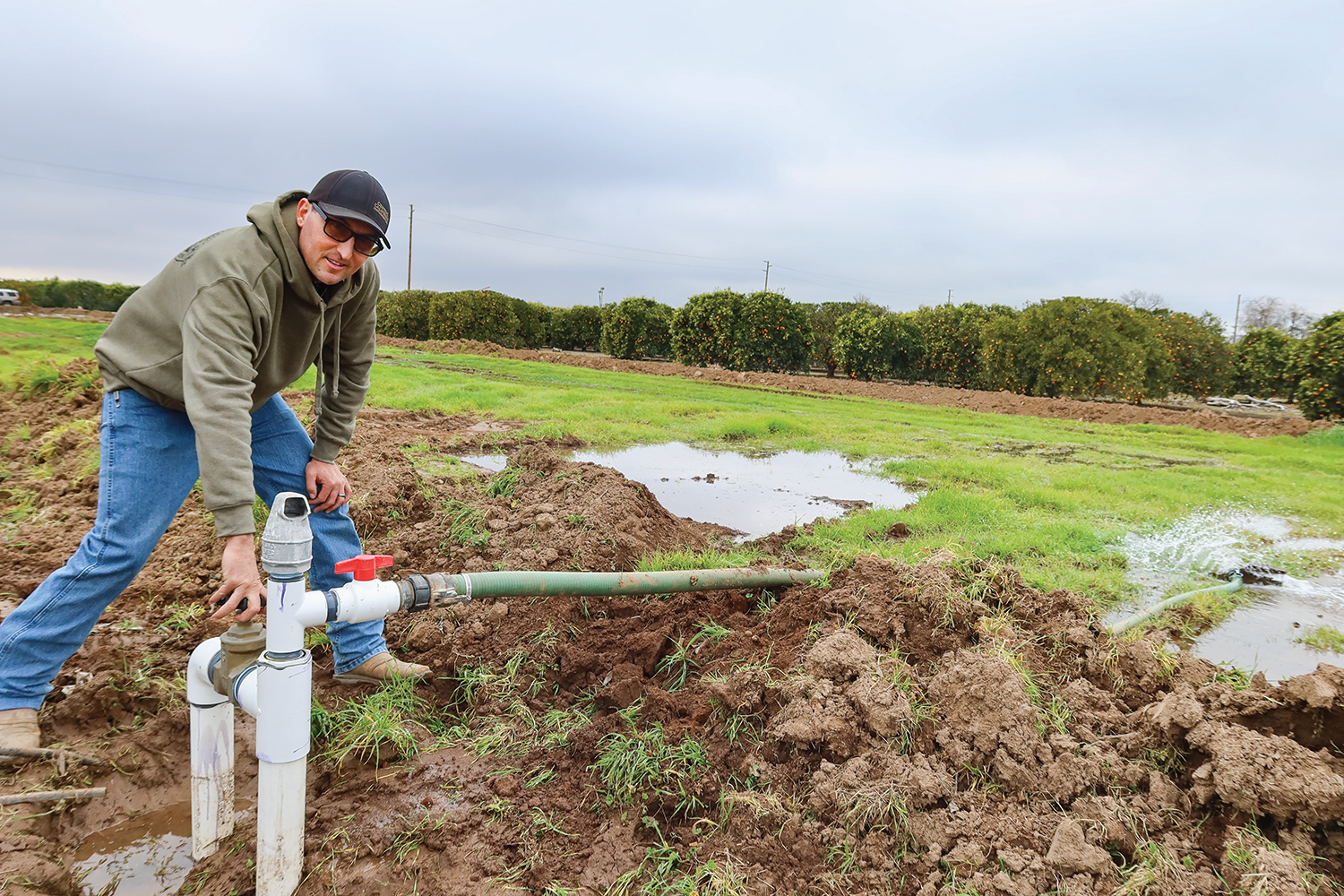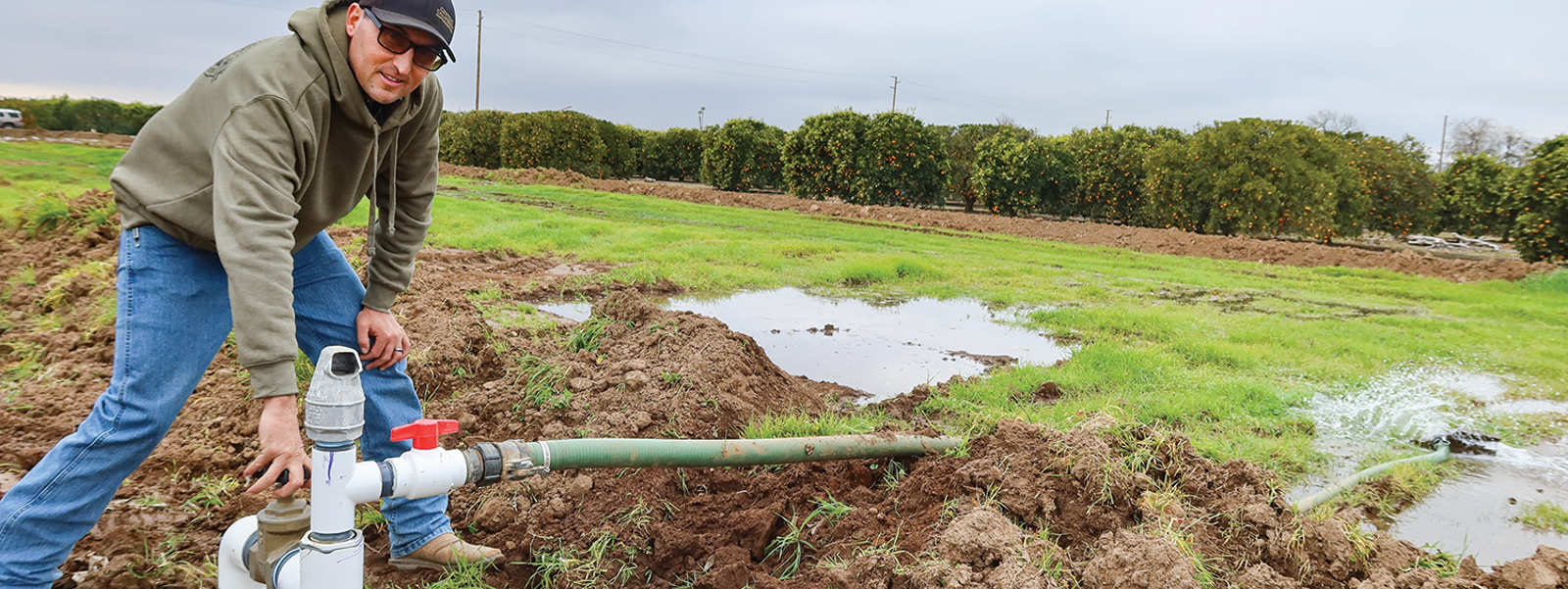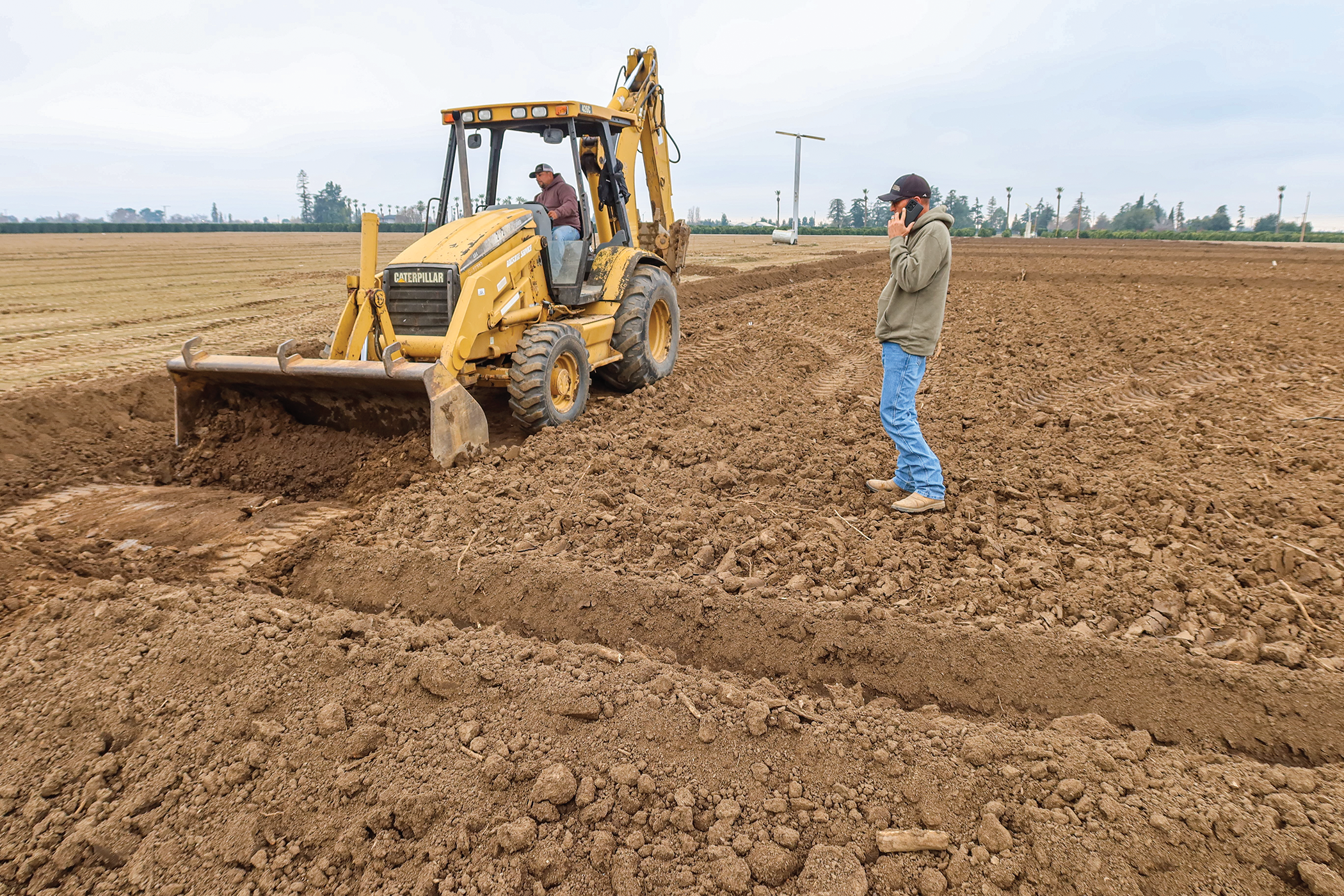Farmers race to sink water into ground after storms


Zack Stuller is working with farmers in Tulare County to help them take advantage of inexpensive seasonal water to recharge farm aquifers and build up credits under California’s groundwater law.

By Lisa McEwen
Growers in the San Joaquin Valley are hurriedly building temporary groundwater sinking basins to take advantage of inexpensive, uncontrolled seasonal water. And they are racing to replenish underground water supplies that could carry them through drier years ahead.
In Tulare County, farm manager Zack Stuller’s phone started ringing nonstop in late December, after a series of intense storms fueled by atmospheric rivers walloped California, dumping snow in the mountains and rain in the lowlands.
Clients of Stuller’s farm management and land development business took note of conditions in the San Joaquin River and Kaweah River watersheds and anticipated an opportunity to conduct on-farm recharge—if they had a place to put it.
“Everyone is scrambling,” Stuller said as he surveyed a recent project in Exeter. “We weren’t prepared for this much water, and we can’t build them fast enough.”
In the past month, Stuller’s crews have built 20 temporary basins, which tend to be simple and inexpensive—think of a backhoe to build berms and pipe or hoses to siphon water from an irrigation district turnout. Depending on the connection, the water slowly dribbles out or is transported through pipes to spread as evenly as possible throughout the field.
Since the U.S. Bureau of Reclamation declared uncontrolled season water in late December, farmers who are Friant Division water users figured out ways to sink water rather than let it go downstream until Feb. 10, when the release ended.
The Friant Division of the Central Valley Project delivers water to more than 1 million acres of irrigable farmland on the east side of the southern San Joaquin Valley, from Chowchilla to the Tehachapi Mountains. Water travels via the Friant-Kern Canal, which the Friant Water Authority maintains and operates, with San Joaquin River water stored at Millerton Lake. The water serves more than 30 irrigation districts and cities, and 15,000 family farms.
Due to California’s 2014 Sustainable Groundwater Management Act, “everyone is coming up with ideas of how to get water in the ground,” said Stuller, who sits on the boards of two area Groundwater Sustainability Agencies, or GSAs, that oversee the health of groundwater basins.
“The more we can distribute locally, the better. It’s like putting money in the piggy bank,” Stuller said.
The metered water is reported through irrigation districts to their corresponding GSA, and growers receive credit for adding water to the groundwater profile. For the East Kaweah GSA, which includes the Tulare basin, the credits are valid for five years, and future surface water allocations will not be affected.
In addition to temporary basins, growers are also letting water run through natural waterways that traverse their ranches, such as creeks or ditches, or running it through their existing irrigation infrastructure. Some growers are using already open ground while others are removing trees to build permanent structures.
Citrus grower David Atkinson of Atkinson Acres in Exeter made the decision to remove 75 Gold Nugget mandarin trees—with the crop still on—to build a permanent half-acre pond for recharge. He initially wanted to build it in the fall but backed out. Motivated by uncontrolled season water priced at $38 an acre-foot, he pulled the trigger on the project. He said he wished he had done it sooner.
“I could have been sinking water for two weeks now,” he said. “But this is an opportunity to put water in the ground, and I’m going to do as much as possible for as long as possible. We’re not doing this for this summer; we are doing this to build up credit for the future. And there’s a possibility that when I get this crop off, I will take out more trees and double the size of the pond.”
In the past, he has purchased water at $1,700 an acre-foot to get through the season. Considering the difference in price, installing a small project is common sense and a cushion for future lean times.
“There are a lot of growers with their head in the sand who are not thinking about this water situation enough,” he said. “But it’s going to become our reality.”
Atkinson said he also used the inexpensive water for frost protection, running it through his micro sprinklers. “I didn’t really need to have water out there, but it was so cheap we threw it out on the ground,” he said.
Farmer Craig Hornung, who also works as director of technical services at AC Foods, is overseeing four recharge projects for the company. The company recently closed escrow on property it purchased specifically for construction of a permanent sinking basin. To capitalize on the uncontrolled season water, though, Hornung quickly turned the piece into a temporary basin by adding berms.
“It’s like building a car as we’re driving it down the road,” he said. The goal is to sink an acre-foot of water per acre per day.
The projects have been a learning curve, but modifications he’s made include deep-ripping ground to encourage water to percolate and using gated pipe — aluminum pipe used mainly for sending water down furrows of row crops — along the side of the field to evenly spread water throughout.
Taking a proactive approach to capturing water to balance out dry years is gaining momentum with increased recognition of wet year-dry year cycles in the state’s weather patterns.
Mike Hagman, general manager of Lindmore Irrigation District in southeastern Tulare County, said growers in his district are now building temporary and permanent basins alike. The district has also purchased land to build its own basins to sink water on behalf of all growers. Typically, the district’s irrigation system would be “off” to perform winter maintenance as irrigation is rare in colder months. But with the arrival of uncontrolled season water, the system is on and growers are paying $75 an acre-foot.
“Our objective now is to run that bugger all the time and try to get as much water in the ground as we can,” said Hagman, who is also executive director of the East Kaweah GSA.
The east side of Tulare County “is in deep trouble,” he said, as the area has reached minimum thresholds on water quality and sustainability in the basin due to overdrafting. “This water is a godsend for us. We needed this precipitation to avert real disaster,” Hagman said.
Exeter Irrigation District manager Gene Kilgore agreed.
“What this does is buy us some time,” he said. “Otherwise, it was going to get ugly. In 35 years in the water business, I’ve never seen two wet years back to back. Knowing this, I am asking my growers to look at their operations and ask themselves how they can be more sustainable.”
Kilgore said steps include fallowing ground, switching from permanent plantings to row crops or using open ground for recharge.
Hornung, who serves as vice chair of the East Kaweah GSA, said he anticipates more uncontrolled season water to be released, considering the size of the snowpack in the Sierra Nevada, which topped 200% of average in a Feb. 1 snow survey.
“My thought is that you have to be prepared every year,” Hornung said. “Every grower needs to do this because we are going to have to recharge this groundwater. It won’t be easy, and it won’t be overnight. If we’re going to survive in the SGMA world, it’s something we’re going to have to do.”
As for Stuller, winter months are typically quiet for the land development side of his business, so he said he is grateful for the extra work of building temporary and permanent sinking basins.
“There will be more releases in the future, and growers need to think about that going forward,” he said. “It’s a tough pill to swallow to set aside a spot on their ranch for recharge, considering the price of land. But if every grower could do this, we could sink a lot of water.”
(Lisa McEwen is a reporter in Tulare County. She may be contacted at mcewenlisamarie@gmail.com.)




